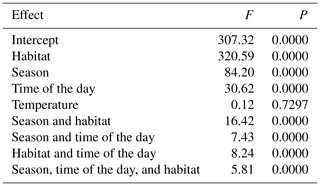the Creative Commons Attribution 4.0 License.
the Creative Commons Attribution 4.0 License.
An analysis of the annual mobility of Polish Konik horses depending on habitat, season, and time of the day
Ryszard Pikuła
Daniel Zaborski
Wilhelm Grzesiak
Mirosław Smugała
The aim of the present study was to analyse the mobility of Polish Konik horses in their natural environment. The study was conducted on a herd of 15 Polish Konik horses in 2018. The Global Positioning System (GPS) transmitter was used to track the horses' movements. Two habitats (forest and meadows), four seasons (autumn, winter, spring, and summer), and four times of the day (morning, midday, evening, and night) were distinguished. Season, habitat, and time of the day as well as the interaction among them significantly (p<0.0001) affected the mobility of Polish Konik horses. The use of the GPS device enabled tracking of horses' mobility also at night, which made the results more complete compared with other similar studies.
- Article
(2218 KB) - Full-text XML
- BibTeX
- EndNote
Polish Konik is the only primitive horse breed originating directly from wild tarpans (Equus caballus gmelini Ant.) (Kownacki, 1995). Tarpans are considered by many authors (Vetulani, 1933; Zwolinski, 1976) to be the original wild form, i.e. a distant ancestor of many horse breeds. Others state that tarpans were feral domestic horses (Czapski, 1874). The Polish Konik breed was mainly formed under natural environmental conditions. Therefore, it retained many traits of primitive horses, which allows researchers to study the natural behaviour of these animals.
In order to preserve the breed and its primitive traits, Polish Konik horses are reserve-bred, which involves free-range rearing, the lack of human intervention, and exposing the horses to natural selection factors (PZHK, 2020). Researchers have aimed at understanding the biology of Polish Konik for years. Kownacki et al. (1978) performed 24 h observation of Polish Konik herds, but only the application of modern research methods such as the Global Positioning System (GPS) has made it possible to fully characterize the migration patterns and locomotor activity of free-living Polish Konik horses.
The need of horses, formed during evolution, is movement, which, under natural conditions, is mainly stimulated by the satisfaction of hunger and thirst, migration, or escape from danger. It also determines social contacts and herd hierarchy (Rehm, 1981). Lack of movement not only results in a series of problems associated with the locomotor system (such as tendon weakness, reduced bone density, and abnormalities in the hoof structure and mechanics) (Porr et al., 1997; Nielsen et al., 2000), but also negatively affects the circulatory and respiratory systems (Vervuert and Coenen, 2002).
Polish Konik horses have also been used in nature reserves created to replicate Europe's prehistoric past, i.e. to “rewild” the area, by populating it with the kinds of animals (e.g. tarpans) that lived there many thousands of years ago. For instance, the population of Konik horses was acquired from Poland in the 1980s and used as “proxies” for extinct tarpans in the 6000 ha Oostvaardersplassen nature reserve in the Netherlands. Konik horses, Heck cattle, and bison were also introduced to a similar 5700 ha nature reserve, located near Lake Pape in Latvia (Marris, 2009). Therefore, reserve breeding is of economic significance to active environmental protection, and Polish Konik horses constitute a valuable source of genetic resources.
Finally, the improvements in spatial and temporal data resolution, reduced device size, and increased battery longevity made GPS technology suitable for the analysis of horse movements over a continuous period of time and not only over a certain part of the day (Hampson et al., 2013; Krueger et al., 2014; Hennig et al., 2018; Walden-Schreiner et al., 2018). Studies on Polish Konik horses which are kept in a stable or reserve system provide information about the natural behaviour of horses as well as their greater healthiness in comparison with animals maintained under artificial conditions created by man. Despite seasonal food shortages, Konik horses are granted the so-called “five freedoms” of well-being, which is confirmed by their good health, longevity (up to 37 years), high reproductive performance, and social relations. Therefore, the understanding of the behaviour of free-living horses is the basis for establishing modern stabling systems. The present study focuses on locomotor activity as a factor that played a major role in the evolution of Equidae. Similar conditions should be created for modern horses, which are open-space animals that feed themselves in motion (Salau et al., 2020). Free-roaming horses cover a daily distance of about 6 km, whereas those housed in box stalls cover only 800 to 900 steps. One example of the practical application of this knowledge is the so-called paddock paradise system (Jackson, 2006).
Therefore, the aim of the present study was to analyse the seasonal mobility of Polish Konik horses in their natural environment using GPS technology.
The study on the distance covered by Polish Konik horses was conducted in a forest and meadow area of 700 ha in the Zagroda breeding reserve, which is located in the Kliniska Forest District near Szczecin. The observations were carried out between 2018 and 2019 using the Global Positioning System (GPS) transmitter (Ecotone, Gdynia, Poland) attached to a broodmare (the so-called wolf collar) from a herd of 15 horses led by the stallion Nagaj. The device sent the data on herd location every hour, which was the basis for determining the distance covered by horses during 1 h. The distance was expressed in metres in the so-called straight line. An example of the tracks used by the horses within the nature reserve area is shown in Fig. 1. During the study period, there were two herds, but the second one was under formation (in a different part of the nature reserve located about 8 km from the territory of the studied herd) and consisted of several horses. Therefore, interactions between herds did not occur, so they did not affect mobility. No other interactions were found during the study period; however, they cannot be completely excluded. The horses were additionally fed with hay during winter. The hay was provided in the area between the meadow and the forest in December, January, and February, practically every second day. The methods were described in detail in our previous work (Pikuła et al., 2020).
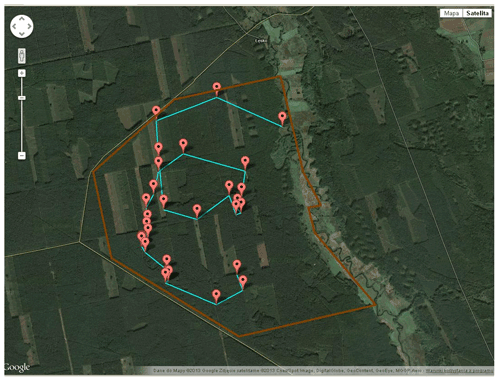
Figure 1An example of the tracks used by the horses within the nature reserve area. Map data © 2013 Google, Satellite image © 2013 Cnes/Spot Image, DigitalGlobe, GeoContent, GeoEye, MGGP Aero.
Two basic habitats were distinguished in the present study:
-
forest, including the area of old-growth forest, coppice, forest plantations, fire lanes, and clearings, and
-
meadows, including the area of meadows (approximately 70 ha) located along the Ina River.
To investigate the spatial and temporal trends in the migration of Polish Konik horses within the habitats, Ecotone software was used. The distance was recorded for 24 consecutive hours (over the period of 30 d during each season), which were grouped into the following times of the day:
-
morning, from 06:00 to 12:00 local time;
-
midday, from 12:00 to 18:00 local time;
-
evening, from 18:00 to 24:00 local time;
-
night, from 00:00 to 06:00 local time.
In addition, season was taken into account in the study, i.e. autumn (the measurements collected in October), winter (the measurements collected in January), spring (the measurements collected between April and May), and summer (the measurements collected in July).
The data were analysed using the following model:
where yijkl is the value of the dependent variable; μ is the overall mean; ai is the effect of time of the day; bj is the effect of season; ck is the effect of habitat; abij is the effect of the interaction between the time of the day and season; acik is the effect of the interaction between the time of the day and habitat; bcjk is the effect of the interaction between season and habitat; abcijk is the effect of the interaction among the time of the day, season and habitat; β is the regression coefficient; xij is the value of the co-variate (mean daily temperature); is the overall mean of the covariate; and eijkl is the random error.
Statistical analysis was carried out using Statistica 13.1 software (Dell Inc., Tulsa, OK, USA). The graphs were prepared using Microsoft Excel (Redmond, Washington, USA).
An analysis of the distances covered annually by Polish Konik horses revealed a statistically significant effect of season, habitat, time of the day, and their interaction (p<0.0000) on locomotor activity (Table 1). Only temperature did not significantly affect the distance covered by horses.
It can be noticed that horses covered the longest average distance in the forest (239 m h−1) and the shortest one in the meadow habitat (about 96 m h−1) (Table 2).
Table 2The mean distance (m h−1) covered by horses depending on habitat, time of the day, and season.
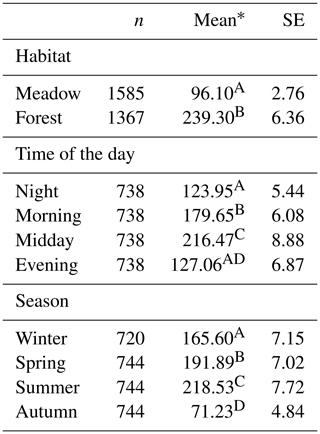
Values within columns marked with different superscripts are significantly different at p<0.01. * The distance travelled per day and month cannot be directly calculated by multiplying the distance travelled in m h−1 by 24 or 720 h. The distance calculated in this way would only be a general approximation, since horses travelled different distances each day and each hour.
Table 3Total time during which horses remained in different habitats and the frequency of habitat change during the day.

The number of hours per month during which horses remained in different habitats is presented in Table 3. Horses spent more time in the forest habitat in winter and, especially, in summer (50.97 % and 62.77 % of the total time, respectively), whereas they spent more time in the meadow habitat in spring and autumn (63.98 % and 66.13 % of the total time, respectively) (Table 3). Horses changed habitat most frequently in winter and spring (seven times during the day; 5.17 and 4.50 times on average, respectively) and least frequently in summer and autumn (three times during the day; 4.09 and 3.45 times on average, respectively). The total number of habitat changes in different months ranged between 107 in autumn and 155 in winter (Table 3).
In the whole year, horses covered the longest average distance during the midday hours (from 09:00 to 15:00 local time). The average locomotor activity of Polish Konik horses increased until the midday hours and decreased subsequently (Fig. 2).
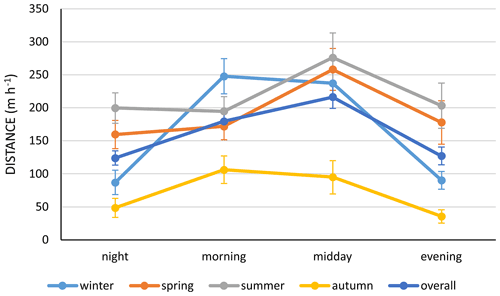
Figure 2The mean distance (m h−1) travelled by Polish Konik horses during different times of the day and seasons.
However, one should notice the differences among individual seasons (the interaction season and the time of the day) (Fig. 2). In general, the locomotor activity increased during the midday hours in spring and summer, whereas it increased already during the morning hours and decreased in the evening in winter. In autumn, activity slightly increased during the morning and midday hours (approximately 50 to 100 m h−1) and decreased subsequently.
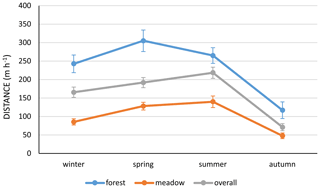
Figure 3The mean distance (m h−1) travelled by Polish Konik horses during different seasons in both habitats.
The highest locomotor activity was recorded in summer (218.5 m h−1) and the lowest in autumn (71.2 m h−1). In winter, horses travelled 165 m h−1 on average and in spring about 192 m h−1 on average (Table 2 and Fig. 3). At different times of the day, horses covered the longest distance in the forest habitat (200–300 m h−1) and a markedly lower one in the meadow habitat (Fig. 4).
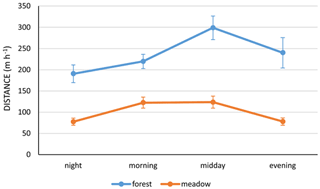
Figure 4The mean distance (m h−1) travelled by Polish Konik horses during different times of the day in both habitats.
However, greater differences were observed in the forest distances than in the meadow ones. The interaction between season and habitat showed that, in the meadows, locomotor activity slightly increased from winter to summer and decreased subsequently. In the forest, locomotor activity increased from winter to spring and decreased slightly in summer. It fell further in autumn (Fig. 3). The three-way interaction between season, time of the day, and habitat was also statistically significant, which resulted in some differences in locomotor activity depending on season and habitat, especially in the forest (Fig. 5).
It can be stated that one of the factors affecting an increased locomotor activity of Polish Konik horses in the present study was the availability of the feed base. They travelled the longest distance in search of food in the forest, i.e. 239 m h−1 on average (5.7 km d−1). This distance differed significantly (p<0.0000) from that covered in the meadow (96 m h−1 on average, approximately 2.3 km d−1). The changes in environmental conditions under which the horses lived were also caused by weather changes in different seasons, protection against sun exposure, and uncomfortable wind conditions. They rarely stayed in the forest for the whole day (more often in winter) or in the meadow (more often in spring or summer). Also, a significant difference in the distance travelled by Polish Konik horses among seasons could have resulted from general weather conditions and the fact that the horses were additionally fed with hay (starting in autumn) and were not forced to move in search of the feed base, like in the warmer periods. Unfortunately, this was human interference which limited the natural need for food search and reduced mobility. Statistically significant differences in the locomotor activity of Polish Konik horses between times of the day were noticed in the present study. They covered the shortest distance during the evening and night hours (approximately 127 and 124 m h−1, respectively; a total distance of about 750 m). In the remaining times of the day, the distances were approximately 180 and 216 m (i.e. a total distance of 1.0 to 1.3 km) (Table 2). In general, the locomotor activity increased until midday and decreased in the evening and at night. It should be mentioned that the monitoring of stock behaviour, especially when released to graze overnight, is rather rare (Walden-Schreiner et al., 2018). During the study period, interactions between herds of horses did not occur. No other interactions were found during this time; however, they cannot be completely excluded. Sporadically, increased mobility occurred during the night period, probably caused by the appearance of predators (such as wolves). A combined effect of season and time of the day, i.e. increasing daylight, on the activity of Polish Konik horses was also observed in the present study, which was confirmed by a statistically significant interaction (Fig. 2). In autumn and winter, the decrease in activity already occurred in the midday and evening hours (this probably resulted from replenishing feeding racks with hay), whereas in spring and summer, horses were still active at this time. The only factor analysed in the present study whose effect turned out to be non-significant was temperature. This finding is in contrast to that obtained by Claudi and Hoy (2013), who reported a significant effect of temperature on daily distances. At temperatures below 10 ∘C, horses moved on average 6722 m each day, and, at temperatures above 10 ∘C, they covered a longer daily distance of 9840 m. The effect of different factors affecting horse mobility identified in the present and other studies is summarized in Table 4.
In general, four keeping systems can be distinguished in Poland: a stable system, which is unrecommended since horses stay only in a stable; a stable–grazing system, in which horses stay on pasture during the day over the season and have access to paddocks after returning to the stable; a grazing system, in which horses remain on pasture all the time; and a cultural-herd system, in which horses stay in an open area throughout the year, supported by humans only under harsh climatic conditions, especially in winter (Pruski et al., 2006). Reserve breeding can be classified into this last method. It is of economic significance to active environmental protection, which requires knowledge of animal behaviour (both wild and domestic; Walden-Schreiner et al., 2018) and is applied not only for primitive horses but also in the extensive breeding of noble horses. Slaughter horses can also be kept in nature reserves. In addition, reserve breeding is used in different types of areas, such as forests (e.g. Białowieża Forest, Popielno) and lowlands (e.g. meadows in Czarnocin near Szczecin Lagoon).
The Polish Konik is a breed of primitive horses, which has its own main herd book. As already mentioned, horses are kept in a stable or reserve system. Herd surplus from reserve breeding is often sold and used as regular horses. The analysis and comparison of keeping methods in the horses of the same breed provide valuable information about changes that should be introduced to stable groups. The understanding of the behaviour of free-living horses is also the basis for appropriate stable keeping and its modernization. Studies on Polish Konik horses indicate an increased role of mobility in stable keeping systems (e.g. the so-called paddock paradise). Moreover, natural behaviour is always an adequate determinant of horse needs in relation to artificial conditions created by man.
In the study by Stanley et al. (2018), semiferal horses showed social stability regarding clique structure and individual network positions. Consequently, the analysis of the evolving contact structure of an inhomogeneous herd of domestic horses which are given the opportunity to move freely and fulfil their need to interact with their conspecifics may be of great interest to researchers studying animal behaviour (Salau et al., 2020). Krueger et al. (2014) identified two main factors affecting the initiation of movement in groups of feral horses using a visual observation method: herding (exclusive to alpha males) and departure (possible for any group member). Social bonds, the number of animals interacted with, and the spatial position did not significantly affect movement initiation. The authors also found a limited form of distributed leadership, with higher-ranking animals being followed more often.
Hampson et al. (2010a) studied the movement patterns of domestic Quarter Horse × Australian Stock Horses, Quarter Horses, and feral horses using GPS. Mean daily distances travelled by domestic horses were, in general, greater in larger paddocks (4.7, 6.1, and 7.2 km for 0.4, 4.0, and 16.0 ha, respectively). Feral horses, living in a 4000 ha paddock, covered the greatest daily distance (17.9 km), whereas those kept in the 6 m × 6 m yard travelled only 1.1 km. In their next study (Hampson et al., 2010b) on feral horses in “outback” Australia, a mean daily distance for all animals was 15.9 km (16.8 and 14.7 km for central Queensland horses and central Australian horses, respectively, but the difference was non-significant). Hampson et al. (2011) also assessed the ability of feral Equus caballus mares to cope in a novel feral environment using GPS. The mares taken from a semi-arid desert remained in good health but changed their movement behaviour when introduced to prime grazing habitat, whereas most mares captured from the prime grazing habitat and released in the semi-arid desert habitat died due to stress or starvation. The mares relocated to semi-arid desert did not easily adapt to relocation and had difficulties in taking up the movement strategy of local horses, which required long distance treks from a water hole to feeding areas. According to Hampson et al. (2011), the movement behaviour, range use, and health consequences of relocating equids may be of great importance to wildlife ecologists, animal behaviourists, and horse welfare groups engaged in relocating domestic or native horses to novel habitats. The study on Przewalski's horses was carried out in Mongolia by Kaczensky et al. (2008) using the ARGOS and GPS systems. It showed that the average daily straight-line distance between the consecutive days of observation was 3.5 km. An effect of season on the mean distance to the nearest water source was found (10.4 and 6.9 km in winter and summer, respectively), which shows that availability of water is an important factor determining space and habitat use for these animals. The analysis of the ranges of Przewalski's horses in the Gobi Desert revealed that the zoo-born animals are able to adapt their spatial use to the local habitat conditions; however their re-introduction to the area can be problematic due to the still-existing factors that caused their extinction such as competition with livestock for steppe habitats with sufficient water supply and interbreeding with domestic horses. Daily and weekly movement distances covered by feral horses in the different states of the USA were analysed by Hennig et al. (2018) using collars with GPS transmitters. The mean daily and weekly values were 9.0 and 62.1 km, respectively. The authors also provided information on the location of horses based on GPS data, which can be helpful in determining their impact on habitats occupied by other species. The GPS was also used in the study on horse-influenced habitat alteration and the correlation between utilization distributions generated from feral horses and dung pile density (Hennig et al., 2021). According to the authors, utilization distributions were a poor predictor of cumulative horse use, and additional management actions regarding feral horse use are needed to sustain high-quality habitat occupied by other species. In their subsequent study on the influence of digestive morphology and feeding strategy on the movement syndromes of feral horses in an arid-cold steppe of North America, Hennig et al. (2021) found that the animals exhibited more sedentary movements largely driven by selection for high biomass patches and areas closer to water.
An effect of the physiological status of dairy mares on their daily distance was investigated in Mongolia by Bat-Oyun et al. (2018) using the GPS method. The daily cumulative distance (approximately 0.6 to 1.0 km h−1) and the daily maximum linear distance (about 3.1 to 3.8 km) differed significantly between the milking and non-milking periods. Finally, Claudi and Hoy (2013) found large individual differences in a daily distance among horses of different breeds using the GPS method. The distance (from 5.1 to 10.3 km) was not affected by age or sex, but breed had a significant effect on it (9.5, 8.1, and 7.7 km for Friesian horses, warmblood horses, and Connemara ponies, respectively). In the technical context of locomotor activity monitoring, Walden-Schreiner et al. (2018) designed an integrated system of behavioural analysis merging direct observation (frequently used for validating sensor-derived behaviour classification) and GPS data. The system was subsequently applied to monitor horse behaviour (grazing, moving with intent, rolling loafing, drinking) in the montane and subalpine meadows of the USA. It turned out to be efficient in tracking and visualizing animal movements, including periods when direct observation was not possible, e.g. multiple movement patterns associated with grazing that could only be identified by integrating the two methods. This novel system can also be applied to other pack animal species aiding in monitoring and management of domestic animal use and their impacts in natural areas. The methods of behavioural analysis in feral horses are still advancing, making use of modern devices such as drones (Inoue et al., 2019).
GPS may constitute a valuable source of information about the mobility of free-living horses. This mobility was significantly affected by season (higher mobility in summer and significantly lower in autumn), habitat (higher mobility in the forest and lower in the meadow), and time of the day (higher mobility in the morning and midday and lower in the evening and at night) as well as the interactions among them. Horses changed habitat most frequently in winter and least frequently in autumn. In the present study, the use of the GPS device enabled tracking of horses' mobility also at night, which made the results more complete compared with other similar studies.
Commercial software was used for data analysis (Dell Inc., 2017; Microsoft Inc., 2021). The commercial software is available from the corresponding author upon reasonable request.
The data are available from the corresponding author upon reasonable request.
RP designed the study and directed and supervised the project. WG and DZ performed the statistical analysis and wrote the paper. MS supported the statistical analysis and interpretation of the results.
The contact author has declared that none of the authors has any competing interests.
According to Polish law, the collection of GPS data from the GPS devices is not classified as experimental work on animals and therefore does not require ethics committee approval (Resolution Number 22/2006 of the National Commission for the Ethics of Experiments on Animals, 7 November 2006).
Publisher’s note: Copernicus Publications remains neutral with regard to jurisdictional claims in published maps and institutional affiliations.
This paper was edited by Antke-Elsabe Freifrau von Tiele-Winckler and reviewed by two anonymous referees.
Bat-Oyun, T., Ito, T. Y., Purevdorj, Y., Shinoda, M., Ishii, S., Buho, H., and Morinaga, Y.: Movements of dams milked for fermented horse milk production in Mongolia, Anim. Sci. J., 89, 219–226, 2018.
Brinkmann, L., Gerken, M., and Riek, A.: Adaptation strategies to seasonal changes in environmental conditions of a domesticated horse breed, the Shetland pony (Equus ferus caballus), J. Exp. Biol., 215, 1061–1068, https://doi.org/10.1242/jeb.064832, 2012.
Claudi, K. and Hoy, S.: Measurements of distances moved by horses in an active stable by GPS, Tieraerztliche Umsch., 68, 486–490, 2013.
Czapski, M.: The Common History of the Horse, Poznań, The Common History of the Horse, J. K. Żupański, 430 pp., 1874.
Dell Inc.: Statistica (data analysis software system), version 13.1., 2017.
Golonka, M.: Analysis of chosen behavioral forms of Konik Polski horses from the Popielno Reserve, Ann. Wars. Univ. Life Sci. Anim. Sci., 46, 255–259, 2009.
Hampson, B. A., de Laat, M. A., Mills, P. C., and Pollitt, C. C.: Distances travelled by feral horses in “outback” Australia, Equine Vet. J., 42, 582–586, https://doi.org/10.1111/j.2042-3306.2010.00203.x, 2010a.
Hampson, B. A., Morton, J. M., Mills, P. C., Trotter, M. G., Lamb, D. W., and Pollitt, C. C.: Monitoring distances travelled by horses using GPS tracking collars, Aust. Vet. J., 88, 176–181, 2010b.
Hampson, B. A., Zabek, M. A., Pollitt, C. C., and Nock, B.: Health and behaviour consequences of feral horse relocation, Rangel. J., 33, 173–180, 2011.
Hampson, B. A., de Laat, M. A., Monot, J., Bailliu, D., and Pollitt, C. C.: Adaption of horses to a novel dynamic feeding system: movement and behavioural responses, Equine Vet. J., 45, 481–484, https://doi.org/10.1111/evj.12002, 2013.
Hennig, J. D.: Feral Horse Movement, Habitat Selection, and Effects on Pronghorn and Greater Sage-Grouse Habitat in Cold-Arid-Steppe, PhD Thesis, University of Wyoming, ISBN 9798515255886, 2021.
Hennig, J. D., Beck, J. L., and Scasta, J. D.: Spatial ecology observations from feral horses equipped with global positioning system transmitters, Human–Wildlife Interact, 12, 75–84, https://doi.org/10.26077/z9cn-4h37, 2018.
Hildebrandt, F., Krieter, J., Büttner, K., Salau, J., and Czycholl, I.: Distances walked by long established and newcomer horses in an open stable system in Northern Germany, J. Equine Vet. Sci., 95, 103282, https://doi.org/10.1016/j.jevs.2020.103282, 2020.
Inoue, S., Yamamoto, S., Ringhofer, M., Mendonça, R. S., Pereira, C., and Hirata, S.: Spatial positioning of individuals in a group of feral horses: a case study using drone technology, Mammal Res., 64, 249–259, 2019.
Jackson, J.: Paddock Paradise: A Guide to Natural Horse Boarding, Star Ridge Publishing, ISBN 0965800784, 9780965800785, 2006.
Kaczensky, P., Ganbaatar, O., Von Wehrden, H., and Walzer, C.: Resource selection by sympatric wild equids in the Mongolian Gobi, J. Appl. Ecol., 45, 1762–1769, 2008.
Kapron, M., Janczarek, I., Bocian, K., Pluta, M., Gawryjolek, I., and Lalak, A.: Analysis of daily movement activity of Polish primitive horses (Polish Konik) kept under the conditions of half-natural stable-free management in forest-pasture mainstays, Zesz. Nauk. Prz. Hod., 50, 427–436, 2000.
Kownacki, M.: The origin, history and breeding of the primitive Polish horse, Biology and Preservative Breeding of the Primitive Polish Horse, Popielno, 18–19 May 1995, 5–12, 1995.
Kownacki, M., Sasimowski, E., Budzynski, M., Jezierski, T., Kapron, M., Jelen, B., Jaworska, M., Dziedzic, R., Seweryn, A., and Slomka, Z.: Observations of the twenty-four hours rhythm of natural behaviour of Polish primitive horse bred for conservation of genetic resources in a forest reserve, Genet. Pol., 19, 61–77, 1978.
Krueger, K., Flauger, B., Farmer, K., and Hemelrijk, C.: Movement initiation in groups of feral horses, Behav. Processes, 103, 91–101, 2014.
Marris, E.: Conservation biology: Reflecting the past, Nature, 462, 30–32, https://doi.org/10.1038/462030a, 2009.
Microsoft Excel: Microsoft Inc., Microsoft Excel, version 2021, https://support.microsoft.com/en-gb/office, last access: 9 July 2021.
Nielsen, B., Waite, K., and Bell, R.: Long-term pasture housing promotes bone mineral deposition in third matacarpus of previously stalled weanlings, in: The Elite Show Jumper, edited by: Lindner, A., Lensing Druck Dortmund, Dortmund, Germany, 157–159, ISBN 3000060510, 2000.
Pikuła, R., Zaborski, D., Grzesiak, W., and Smugała, M.: Locomotor activity analysis based on habitat, season and time of the day in Polish Konik horses from reserve breeding using the Global Positioning System (GPS), Indian J. Anim. Res., 54, 494–498, https://doi.org/10.18805/ijar.B-1072, 2020.
Pluta, M., Patkowski, K., Gasinska, B., and Bryczek, E.: Behavior and interactions in and between herds of Polish Konik horse and Uhruska sheep during mixed-species grazing practice, Ann. UMCS Zootech., 31, 49–58, 2013.
Porr, C. A., Ott, E. A., Johnson, E. L., and Madison, J. B.: Bone mineral in young Thoroughbred horses is affected by training, Equine Pract., 19, 28–31, 1997.
Pruski, W., Grabowski, J., and Schuch, C.: Horse Breeding, PWRiL, Warsaw, ISBN 83-7244-696-2, 2006.
PZHK: A Breeding Programme for the Polish Konik Horses, PZHK, Warsaw, 2020.
Rehm, G.: Auswirkungen verschiedener Haltungsverfahren auf die Bewegungsaktivitat und die soziale Aktivitat bei Hauspferden, in: Deutsche Reiterliche Vereinigung u. K. Zeeb, Aktuelle Aspekte der Ethologie in der Pferdehaltung, Wissensch. Publ., Verlag FN, Warendorf, Germany, 81–100, ISBN 10 3885420333, 13 978-3885420330, 1981.
Salau, J., Hildebrandt, F., Czycholl, I., and Krieter, J.: “HerdGPS-Preprocessor” – A tool to preprocess herd animal GPS data; applied to evaluate contact structures in loose-housing horses, Animals, 10, 1932, https://doi.org/10.3390/ani10101932, 2020.
Schmitz, A., Tonn, B., Schöppner, A.-K., and Isselstein, J.: Using a citizen science approach with German horse owners to study the locomotion behaviour of horses on pasture, Sustainability, 12, 1835, https://doi.org/10.3390/su12051835, 2020.
Stanley, C. R., Mettke-Hofmann, C., Hager, R., and Shultz, S.: Social stability in semiferal ponies: networks show interannual stability alongside seasonal flexibility, Anim. Behav., 136, 175–184, 2018.
Vervuert, I. and Coenen, M.: Aspekte der Fütterungs-und Haltungstechnik von Pferden, Pferdeheilkunde, 18, 629–632, 2002.
Vetulani, T.: Two additional sources of the problem with the European Forest Tarpan, Agric. Sci. Ann., 30, 206–212, 1933.
Walden-Schreiner, C., Leung, Y.-F., Kuhn, T., and Newburger, T.: Integrating direct observation and GPS tracking to monitor animal behavior for resource management, Environ. Monit. Assess., 190, 1–15, 2018.
Weinert, J. R., Werner, J., and Williams, C. A.: Validation and implementation of an automated chew sensor–based remote monitoring device as tool for equine grazing research, J. Equine Vet. Sci., 88, 102971, https://doi.org/10.1016/j.jevs.2020.102971, 2020.
Zwolinski, J.: Horse Breeding, PWRiL, Warsaw, ISBN 8309002025, 1976.
rewildthe area, by populating it with the kinds of animals (e.g. tarpans) that lived there many thousands of years ago. The Polish Konik is the only primitive horse breed originating directly from wild tarpans. Researchers have aimed at understanding the biology of Polish Konik horses for years. Our study showed that different factors such as season, habitat, and time of the day affect their mobility.
rewild...






